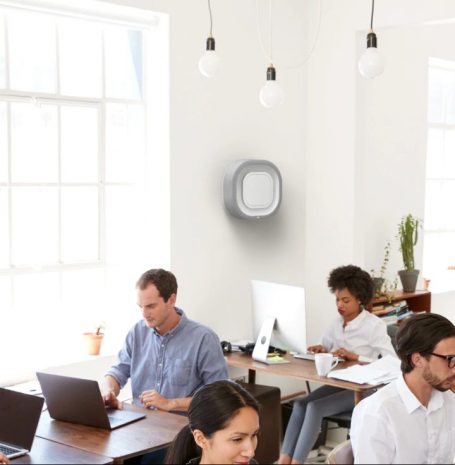


Whether it’s at home or at work, we spend up to 90% of our lives indoors. Air quality is essential for health and wellbeing but even small levels of pollutants can have a direct effect on productivity. The latest intelligent building devices can both monitor and filter the air, enabling them to keep up with varying levels of demand while collecting invaluable real-time data.
A lot of attention is paid to air quality outdoors: many of us are aware of the effects of smog, smoke, traffic and industrial processes on respiratory conditions like asthma. However indoor air can be just as bad, if not worse: studies by the US Environmental Protection Agency (EPA) suggest that indoor workplaces can have levels of pollutants two to five times higher than those outside.
In industrial and manufacturing environments hazards can be given off by equipment, fuels, lubricants and other materials on the production line, but even in office spaces employees are often exposed to a range of chemical compounds and biological contaminants. High numbers of people in relatively small, often enclosed spaces means a great risk of transmission of airborne microbes and increased concentration of carbon dioxide. Without adequate ventilation cleaning chemicals can pose a hazard. Even static office equipment like furniture often gives off harmful volatile organic compounds (VOCs).
At its worst, poor air quality can be responsible for a number of serious and long-term conditions including respiratory conditions, allergic reactions and even cancer. A study by medical journal The Lancet found that 6.5 million people die prematurely every year as a result of poor air quality. Day to day, higher levels of pollutants can cause headaches, poor concentration, fatigue and shortness of breath. Recent studies showed that better air quality has a measurable effect on workers’ cognitive ability and productivity.
Air quality is measured on the Air Quality Index, or AQI. The AQI is a simple scale from 0 to 500 degrees showing the overall quality of the air – it is not specific to one type of pollutant.
Measuring IAQ can be difficult because of the number of different chemicals and biological contaminants that can affect the air. Accurately determining IAQ can involve analysis by different testing devices, collecting samples from surfaces as well as the air, and modelling the airflow inside rooms and across buildings.
Some of the things that affect IAQ include carbon dioxide (CO2), carbon monoxide (CO), humidity, VOCs, fine particulate matter (for example, smoke particles) and biological contaminants such as molds and viruses.
 One traditional method of improving air quality has always been to simply open a window to encourage natural air changeover, but there are limitations to this approach, not least the possibility that the external air is poorer quality than the air indoors. In urban environments opening a window can also increase noise to distracting levels. Humidity can also be affected by the weather outside. Excess moisture can lead to the development of mold, while indoor air that’s too dry can also be an irritant. Many offices today do not even feature openable windows, and in some buildings the flow of outdoor air – the air exchange – may be controlled by the landlord and not the tenants.
One traditional method of improving air quality has always been to simply open a window to encourage natural air changeover, but there are limitations to this approach, not least the possibility that the external air is poorer quality than the air indoors. In urban environments opening a window can also increase noise to distracting levels. Humidity can also be affected by the weather outside. Excess moisture can lead to the development of mold, while indoor air that’s too dry can also be an irritant. Many offices today do not even feature openable windows, and in some buildings the flow of outdoor air – the air exchange – may be controlled by the landlord and not the tenants.
Air conditioning units often feature HEPA filters which contribute toward air quality, but as the primary purpose of HVAC systems is to control temperature their effectiveness is often limited, especially with gaseous pollutants such as VOCs.
Where air quality is a concern, dedicated air filtering devices such as Aura Air are the best solution. Air is actively pulled through multi-layered filters, each designed to trap a different type of pollutants, from relatively large particles to chemical VOCs. Internal sanitization technology can be used to kill bacteria and viruses safely once they are trapped inside the filters. As well as providing an additional level of air purification, this also protects technicians who are changing filters or conducting routine maintenance.
Along with conditions such as temperature and lighting, air quality is an integral component of indoor environmental quality (IEQ). When designing for improved occupant wellbeing, there are benefits to integrating multiple environmental control systems into a more comprehensive smart building platform.
Some pollution occurs passively and continuously, for example, the emission of VOCs from surfaces or cleaning products. However much of the impact on air quality is dependent on activities, such as equipment in operation, the number of occupants in a space, or the type of work they are engaged in, which can cause a rapid degradation of air quality. Information from smart building sensors, such as real-time occupancy data or room scheduling information, can be used to automatically adjust the rate of air turnover before air quality falls. As well as ensuring the air quality remains good in a multitude of scenarios, this saves energy by reducing activity when it’s not needed.
In return, air quality information collected by the filtration system can be collated by the smart building system and analysed in parallel with other sensor data. This has a number of uses – from generating detailed stakeholder reports and reassuring occupants, to providing evidence for certification such as LEED or BREEAM.
The Molex CoreSync Smart Building solution is designed to connect with a range of devices and systems, enabling effortless control of buildings or campuses from a single pane of glass. From lighting to HVAC to safety and security, CoreSync makes it easy to ensure workplace conditions are optimized.
Read more about how CoreSync can be used to improve the occupant experience here
Adding air monitoring and filtration capabilities to a CoreSync installation is easy. CoreSync Alliance members Aura Air are air purification experts, with a range of smart air filters that can be easily integrated with CoreSync. Aura’s products offer advanced all-in-one indoor air monitoring and purification, utilizing a unique five-stage filtering process that targets different contaminant types with specific filters.